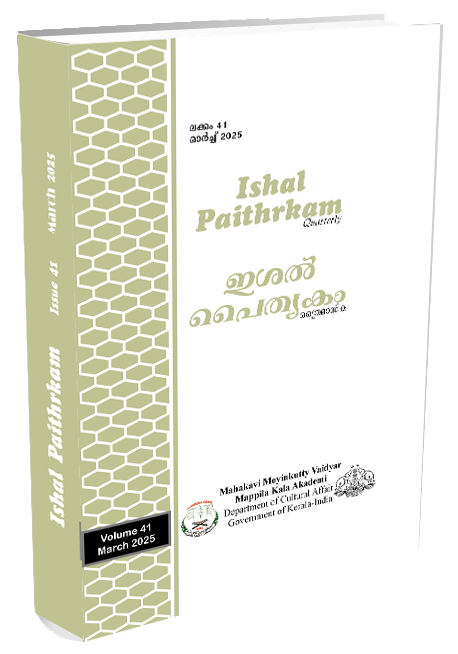Modernity and Communal Reform in Sultan Veed
Keywords:
Community, tradition, modernity, communal reform, local historyAbstract
The novel is a literary form that presents social life in all its complexities. When a real society or a particular community within it is chosen as the focal point in literature, aspects such as the history, culture, geography, social environment, and language of that people and region become highly significant. Sultan Veedu by P. A. Mohammed Koya is a novel that incorporates these characteristics. The novel is set against the backdrop of Kuttichira, a historically significant area in Kozhikode, and the Koyas of that region. This study attempts to explore how modernity influenced the Koya community and the socio-cultural transformations that resulted from it.
Various literary forms have emerged in all languages as part of socio-cultural reform. The isolated reform movements in Kerala were all part of a broader renaissance process. Most caste and religious groups, including the Namboothiris, Nairs, Muslims, Christians, and Dalits, had their own reform movements, which were also associated with political awakening. This novel also embodies such an objective. Sultan Veedu follows the conventional narrative pattern of modern Malayalam novels, in which the protagonist’s emotional turmoil is unveiled. Since the novel tells the story of a particular community in a specific region, the impact of modernity is evident throughout. Progressive ideas and events manifest differently across regions, societies, and communities. The emergence of new perspectives in political and religious spheres played a crucial role in the transformation of this community. Alongside this, capitalism also found its foothold. The growth of capitalism in the first half of the 20th century transformed Kozhikode into a modern urban space, and the novel reflects these changes.
A key characteristic of the period in which the story is set—starting from the 1920s—is that it was the era of the Malabar Rebellion. Broadly speaking, this was also a time when Mappila Muslims began to organize themselves. In other words, it marked the beginning of an awareness of transformation, even among the minority within the community. The novelist employs the rejection of tradition, a hallmark of modernity, as the primary means of making the protagonist, Ummar Koya, modern. By openly opposing the rigidities of tradition, customs, and rituals, he embraces modernity. As a result of this modernization, Ummar Koya undergoes a transformation. However, the novel does not portray the possibility of community-wide reform for everyone in the ‘tharavad’. Instead, through Ummar Koya, the novelist attempts to showcase the comprehensive nature of socio-cultural reform in line with the times. His journey serves as an attempt to create a model for others to follow. The narrative of Sultan Veedu unfolds simultaneously at the levels of the land, the community, and the individual. Through its multilayered readings, the novel also holds potential as a valuable resource for regional historical studies.
Downloads
References
Jameel Ahammed. (2017 November -2018 January). Sulthan Veed' Kuttichirayude Ithihasam. Kavana koumudhi thrai masika, ISSN 2456-2513
Mammad Koya, P.P. Parappil. (2012). Kozhikotte muslingalude charithram. Kozhikode: Vachanam books.
Muhammed Koya, P. A. (2021). Sulthan Veed. Kozhikode: Olive Publications.
Paul, M. P. (1998). Novel Sahithyam. Kottayam: Sahithya Pravarthaka Sahakarana Sangham, 12th Edition.
Raveendran, P. P. (2017). Aadhunikatha. Aju K. Narayanan (Edi.) Thakkol Vakkukal Vijara mathrukakal Keraleeya Nottangal. Aluva: Vidwan P. G. Nayar Smaraka Gaveshana Kendram.
Downloads
Published
Issue
Section
License
Copyright (c) 2025 ISHAL PAITHRKAM

This work is licensed under a Creative Commons Attribution-NoDerivatives 4.0 International License.

